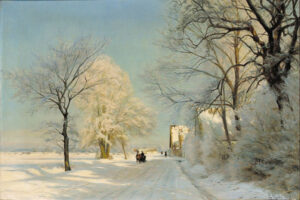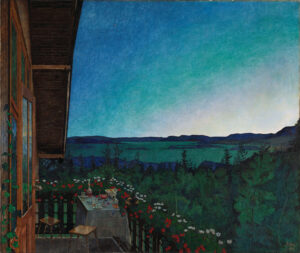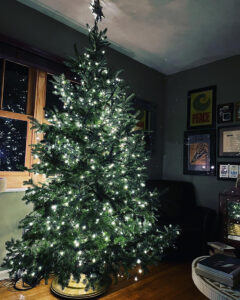If you read as many 19th and early 20th Century books as I do, you may come to the same conclusion as I have about the weather: Christmas was definitely colder and snowier back then. Washington Irving’s traveler in the Sketchbook of Geoffrey Crayon, Ebenezer Scrooge and the ghosts that visit him in Charles Dickens’ A Christmas Carol, Dick Dewey and the full cast of characters of Thomas Hardy’s Under the Greenwood Tree, Dylan Thomas’ child in A Child’s Christmas in Wales: all of these characters experience frosty, snow blown Christmases, the likes of which we rarely see these days, or so it seems to me. But what do I know? I live in Florida. It was 1977 when it last snowed here in Lake Worth. Our niece, who lives nearby, is bound for Maine to spend Christmas with her grandparents and she was hoping for snow, but instead the forecast there is calling for unseasonably warm temperatures. Where’s the fun in that, especially when it is Christmas?
Even here in this strange green land, cold is part of what we long for in Christmas, part of what makes Christmas, well, Christmas. We celebrate Christ’s Mass––Christmas––around the time of the Northern Hemisphere’s Midwinter solstice, but, in fact, we don’t really know when Jesus was born. It was the early Church, working within the confines of the Wheel of the Year, that placed his holy birth at the Midwinter Solstice. To the Midsummer Solstice, the Church assigned the birth of his cousin, St. John the Baptist. And so John is born at the brightest time of the year, just a few days past June’s solstice, the time of our longest days. But with Midsummer’s passing, the days already begin to grow shorter, and John himself tells us this: “I must decrease so he may increase.” John prepares the way for Jesus, the Light of the World. Which is why we celebrate the birth of Christ now, at the opposite pole of the year, the time of our darkest, longest nights, just as daily sunlight is at its minimum and is again about to increase. It is the old, old story, a rich and beautiful metaphor, attached to the even older story of the rhythm of our planet as it circles around the sun each year, tilted as it is on its axis, the tilt creating the seasons that are the basis of all our celebrations in the Wheel of the Year. Each day different from the one before and the one after: the constant rearrange that takes us from winter to spring to summer to fall and to winter again. It is the story we all know. And here we go again: In this bleak midwinter, light is born, the child is born, and now light again begins to increase. By Candlemas on the Second of February, when the Christmas season officially ends and when St. Brigid invites us to take our first steps upon her bridge to springtime, we will already be halfway between the Midwinter solstice and the Vernal equinox. There is nothing random about the days we celebrate. There is purpose and meaning behind them, as we tell the story over and over again: this story that never grows old. It is always fascinating. Always amazing.
As precision goes, the solstice moment this time around (more or less, for there are variations east and west within time zones), is 10:27 PM here in US Eastern Standard Time. That is the moment when the sun’s rays strike their southernmost point at the Tropic of Capricorn, south of the Equator, and in the Southern Hemisphere, today brings the Midsummer solstice and the longest day. Polar opposites: their longest day, our longest night.
Here at our home in Lake Worth, we’ll mark this longest night by lighting a fire in the backyard copper fire bowl. Our Midwinter fire will be fueled by the remnants of last year’s Christmas tree, which has been drying in a quiet corner of the yard since we brought it out there last February at Candlemas. A quiet ceremony on a chilly night in which the embers in our fire glow and shimmer and share the same winter sky as the stars that twinkle above.
SPECIALTY FOODS SALE
You’ll find savings right now on European Christmas cookies and candies (and more) in the Specialty Foods section of our online shop (CLICK HERE to SHOP). The markdowns are automatic, and you can also take an additional $10 off your order of $85 when you use discount code SLOWCHRISTMAS at check out, and we’ll pay your domestic shipping at that level, too. (Our flat rate shipping fee is $9.50 for all domestic orders below $85.) While your order won’t be delivered by Christmas Day at this point, you’ll certainly have your order in time to enjoy for the Twelve Days of Christmas, though, which begin only once Christmas Day itself has passed. Aside from the cookies and chocolates in our shop, there are some important pantry items to have on hand to make your Twelve Days as wonderful as possible: I’d suggest stocking up on chestnuts at your local Italian market to enjoy throughout the Christmas season, and from us, may I suggest Shaker Mulling Spices so you can make mulled wine and Shaker Rose Water so you can make baklava and our Three Kings Cake come Epiphany.
Image: Bernstorffsvejen ved Rygaard, Rimfuld Vintermorgen (The Road Bernstorffsvej at Rygaard on a Frosty Winter Morning) by Christian Zacho. Oil on canvas, 1905 [Public domain, via Wikimedia Commons].


